A typical scene from Amsterdam is full of bicycles, bike paths, and very well organized cycling infrastructure. In fact, the most often taken photo from Amsterdam is the bike parking in front of Centraal Train Station. But has it always been like this? Of course not. In this article, I will share with you a general overview of a cycling culture in Amsterdam.
The cycling culture in Amsterdam is a result of a few decades of hard work and fight for cyclist rights. Bike infrastructure, low number of cars, and people aware of the bicycle traffic make cycling in Amsterdam safe and very well organized.
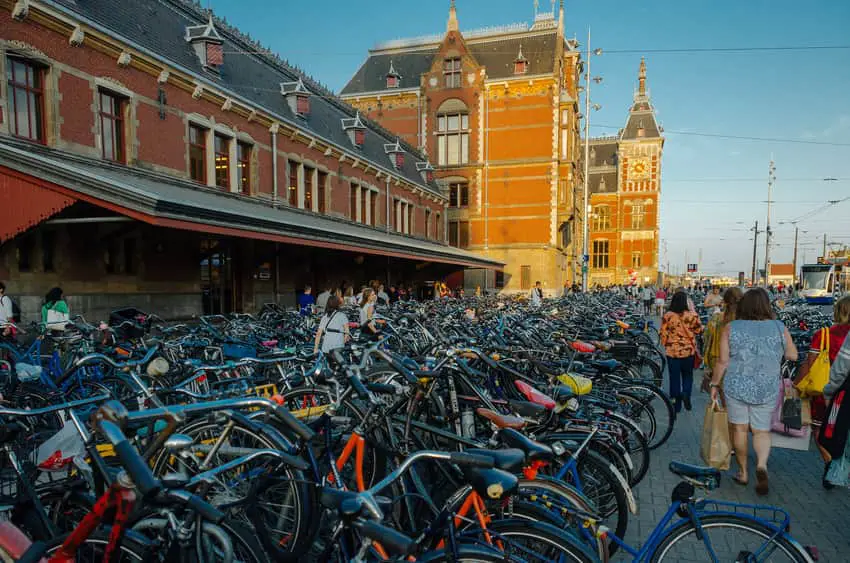
In this article, I will describe a cycling culture in Amsterdam. You’ll learn a little bit about the history of cycling in the Netherlands. I will answer some of the most frequently asked questions such as: why Dutch do not wear helmets and why all bicycles in the Netherlands are old? Enjoy!
A Brief History Of Cycling in Amsterdam
Late 19th century
The history of cycling in the Netherlands is not that long as you may think. The first bikes were created in the Netherlands in 1869. It’s only 150 years ago. The mass adaptation of bikes started in 1890, and then the real production started. In the years 1899 -1903 the number of bikes in Holland doubled. During this time bike was becoming slowly one of the most important means of transportation.
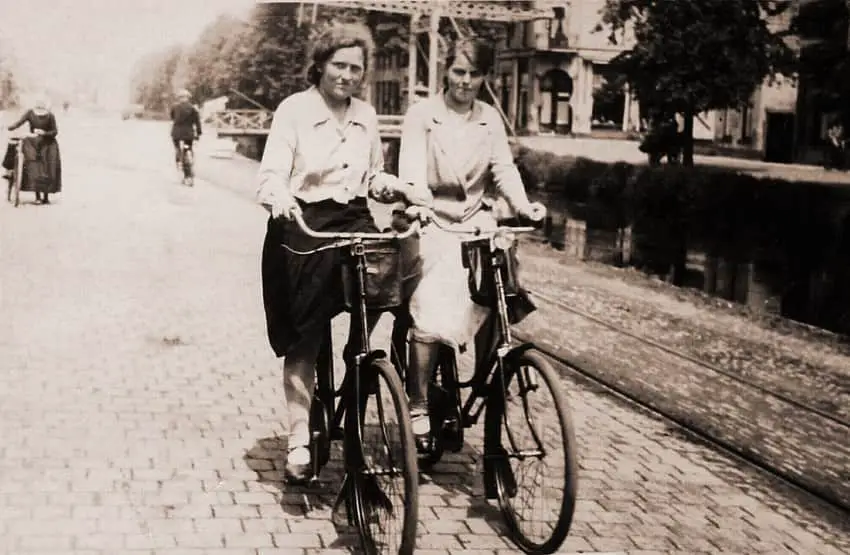
Second World War
This unfortunate period of time in our history was a big hit into the Dutch bicycle industry. It was a period when German and international producers started production in the Netherlands. It was a difficult time for Dutch companies but it was good for cycling in general. Bikes were getting more and more popular. In the time of war, the overall production was much lower, and the biggest issue was to get replacement parts. After 1942 many production machines were disassembled and taken to Germany. The war had a big impact on this industry. After the war bicycles were barely available.
Post II World War
After the war, the economy was skyrocketing. The average salary increased drastically and thanks to that people could afford much more expensive goods. It was a period when cars took over the streets of the Netherlands. Car infrastructure was created, buildings were demolished and in their place, streets were built. City centers were transformed into car parking. But car transportation in the Netherlands was not fulfilling its role. Dutch streets were not that safe anymore. There were too soo many accidents involving children that at one point Dutch citizens started demonstrations against car revolution. This movement was called Stop De Kindermoord. in 1971 itself number of deaths in car accidents reached a number of 3300 and 400 of this were children.
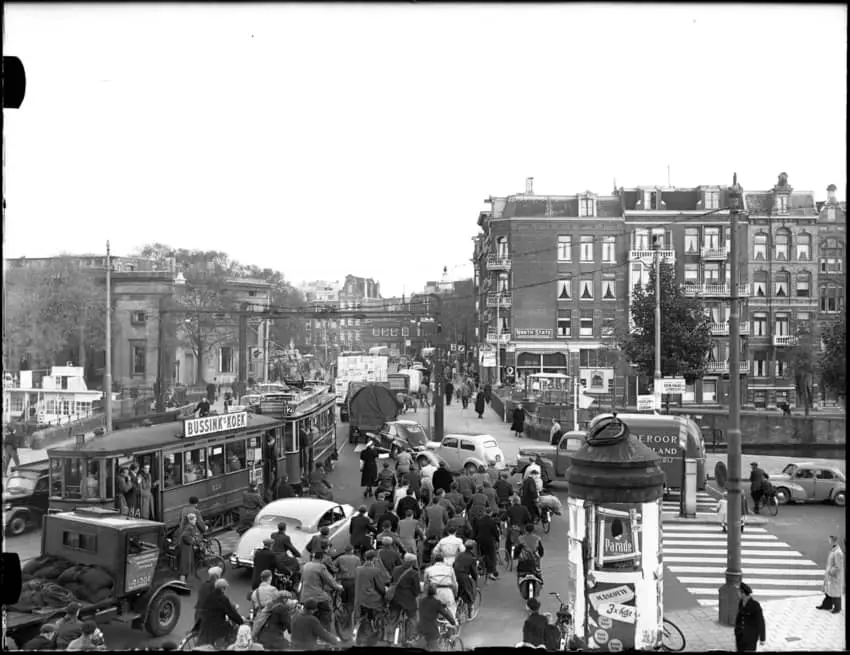
After successful Stop De Kindermoord demonstrations, there was still plenty to do. First Only Real Dutch Cyclists’ Union was established and their goal was to create more space for bikes and better cycling infrastructure. As time pass, the Dutch government started realizing that they must focus more on bicycles, the safer and more sustainable way of transportation. Today in Amsterdam itself there is 400 km of bicycle paths. In the Netherlands, there is over 35 500 km of bike lanes. Is that the end of the growth of the bicycle kingdom? Of course, not, there is still plenty to do. There are many old bike paths that must be reconstructed. Because of constantly growing number of bicycles some old bike paths are no longer useful. They must be wider and adjusted to the higher number of cyclists.
Why There Are So Many Bikes In Amsterdam?
Bicycles are used in Amsterdam on a daily basis, to get to work or school. Why is that? I mention some of the reasons while telling you the history of the Netherlands but there are more factors than that.
Size Of The Country – the Netherlands is a little, flat country. It’s manmade, so the distance to work is not like in other countries. In the US or Australia, you have to drive 30 km to get to work. Of course, this happens also in the Netherlands. There was a time when I was driving all the way from Haarlem to Zaandam and this is exactly 30 km. I have a friend who lives in Den Helder and she drives daily to the Schiphol Airport. What I mean is that Dutch cities are much more compact. When you live in Amsterdam and you don’t travel a lot, you don’t really need a car. Cities are small and dense. Within the city center of Amsterdam, you can get anywhere in 20 minutes. The distance between work and your house is very often less than 10km.
Amsterdam is Flat -The shape of the terrain is also a great advantage. Amsterdam is flat like a pancake and you cycle without any effort. There are no hills at all. It’s very easy to cycle even 10 km a day. When I cycle 20 km a day I still go to the gym at the end of the day, because riding a bike isn’t tiring at all. The terrain is one of the reasons for the mass adoption of bikes in the Netherlands.
Why All Bicycles in Amsterdam are Old?
You’re right. this is true that most of the bikes in Amsterdam are old. I explain to you why. But you should also realize that many of these bikes aren’t old. These are just Dutch-style bikes, old, classic, vintage. However, that’s true that many of these bikes are just old.

- Nobody Steals an Old Bike – The most common crime in Amsterdam is a bike theft and if you have an old bike there is a lower chance that your bike will be stolen. If fact if you have a 50 Euro bicycle and it gets stolen you just buy a new(old) one.
- Bikes Are Often Parked Outdoor – If you have a new bike, of course, you want to keep it indoor. Dutch houses are very small and it’s more convenient to keep a bike outside. That’s why bicycles are constantly exposed to the rain, sun, and wind. These old bikes are extremely sturdy and you can keep them outside. There is often only backpedal brake a no gears so there is nothing that could be potentially damaged.
- No Need For High-Quality Bike – As I already mentioned Amsterdam is flat, and you don’t really need a high-quality bike with 21 gears. Dutch-style bikes tend to be heavy, very heavy and it’s not a big of a deal when cycling on that flat terrain.
- Price – There are many students in Amsterdam, and they want something affordable. On the other hand, it’s nothing surprising to see a guy in a suit on an old bicycle.
- Dutch Don’t Care About Financial Status – Dutch don’t judge others based on the size of their wallet and no one will ever laugh because you have an old bike.
- Dutch Are Penny-Wised – That’s definitely a truth and Dutch are just like jews, they count every penny. I like this. Why would you pay too much when there is no need for that.
Bike Rules
- Don’t Use a Mobile Phone While Cycling – that’s actually regulated by law. Since July 2019 it’s forbidden to ride a bike and use an electronic device at the same time. Please don’t do this. Many times I’ve seen the situation that an accident could happen because someone uses their phone!
- You can turn right on the red light when you can see a sigh ” rechtsaf voor fietsers vrij’ (cyclists free to turn right)
- Maximal of 2 cyclist are allowed to ride side by side, no more!
- When cycling path isn’t wide enough then you have to cycle one by one and allow others to cycle faster on your left side.
- You can park your bike almost anywhere, just be aware of the places with a sign that forbids parking. You can often see it in front of private properties, houses, stores. Don’t park your bike in front of entrances and doors.
- You can pass other cyclists only on their left side, but you can pass other vehicles on the right.
- When it gets dark you must have a working light on the front and back of your bicycle. If you don’t you’ll get a fine.
- Always Give a Sign When You Turn. People cycle fast and if you turn left without any sign this can be dangerous.
- Never Stop Your Bike Without Any Reason. Someone can be very close to you and this will cause an accident.
Why Dutch Don’t Wear A Bike Helmet?
Bike Has Always A Priority
First of all the bike has always a priority and even if there is car-bike accident caused by bike it’s car fault. Car drivers are aware that they have to be very careful. To drive a car you need a license and you know the traffic rules. On the other hand, anyone can ride a bike. When driving a car you must be aware that some people may not know traffic rules. Because of this rule, there are much fewer accidents with car and bike involved.
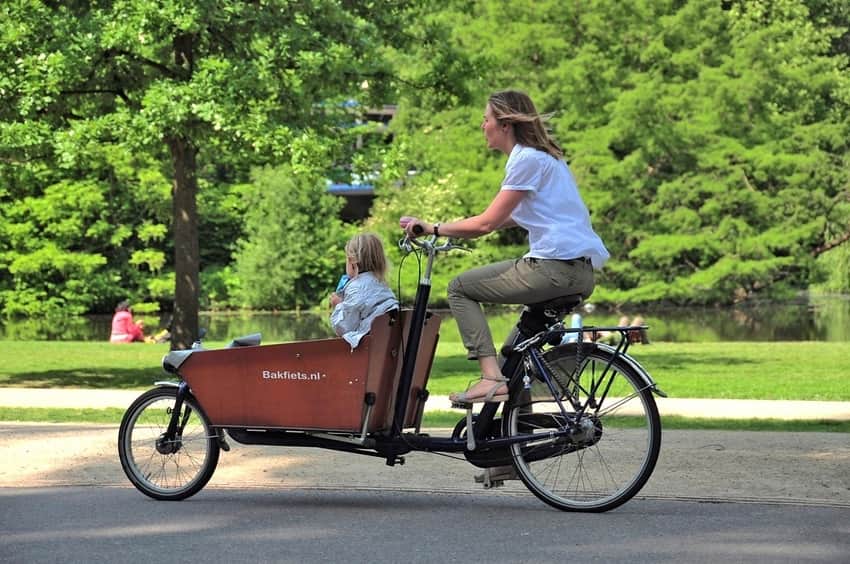
Dutch Are Born On Two Wheels
You must be aware that some people don’t really know the traffic rules, but to be honest it’s more about tourists. Dutch people start cycling when they are little children and they know what they do. In fact, if you are new in Amsterdam they will give you a good lesson by using their bell(or cursing on you) anythime you don’t follow cycling rules. Because of that cycling culture, people understand traffic rules and they are aware of how the whole system works.
Wearing a Helmet Can Be Actually Dangerous
I am sorry to say but there is no helmet that will keep you safe when you hit a car. A helmet may also limit visibility. When they’re a lot of bikes around you need to see everything around very clearly and helmet may be inconvenient in this case.
There is no direct correlation between wearing a helmet and lower accidents rate. According to some statistics, there are fewer accidents in places where helmet is mandatory, but there are also much fewer bikers. When you push people to wear a helmet you make them think that cycling is dangerous and because of that fewer people cycle. In Amsterdam they want more people to use their bikes and fewer people drive a car.
The Reason is Infrastructure
In the Netherlands, bicycles have dedicated bike paths, only for bikes. Very well organized infrastructure makes it safe to cycle. I understand that it’s mandatory to wear a helmet in other countries where there is no cycling infrastructure. There people have to ride their bikes on the streets and it’s dangerous.
Helmets are Problematic
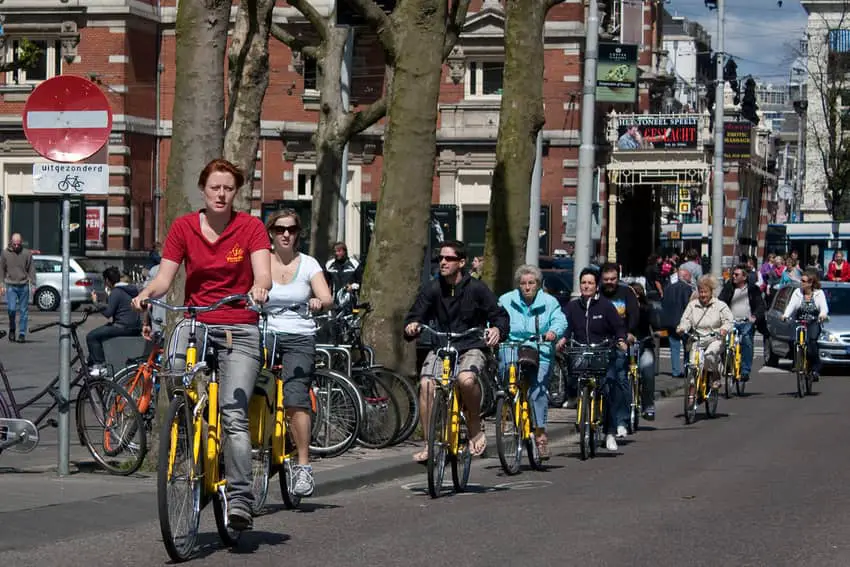
Bikes are used often to ride only short distances. It’s annoying to wear a helmet to cycle just 1 km when you go for groceries. Then you have to carry your helmet around. It’s just inconvenient and everyone agree with that. Even Dutch bike federation is against wearing helmets.
Curiosities about Bikes
Bikes are right and have all the priorities: if you have already been to Amsterdam, you would have noticed all the peculiarities that this city has adopted to be adapted to bikes and all the curiosities Dutch don’t seem to notice. I have been living in the Netherlands for a couple of years now and I still get surprised by certain “bike-related” curiosities.
- Fiets: this is the word for Bicycle in Dutch, a piece of information very important and indispensable if you are moving to Amsterdam or are planning on living there. If you pay attention, you will start reading it everywhere, bikes are part of the city!
- Kids and Bikes: In Amsterdam, when it comes to bikes, kids are no exception. Do not be surprised if you happen to see really young kids cycling along or very fast along the streets of Amsterdam, Dutch naturalise bikes and get used to them since they are born. Being able to walk is a synonym of being able to cycle. This way, by the time children start Primary School, they are more than familiarise with cycling and the know their own way to school. Of course, by bike!
- Bakfiets: The famous bakfiets are those curios transport/cargo bikes Dutch use for everything. The most common usage you will find in Amsterdam is transporting kids. Bakfiets are parent’s favourite way of transporting kids to go to school, a great and practical way of bringing more than one kid at the same time, with backpacks and all the equipment included. A little uncomfortable to ride but nothing impossible for a Dutch. Plus, you can cover them with a special plastic for the rain, super gezellig. Another usage for bakfiets are “food trucks”, or any type of business. The roomy capacity of these bikes make them ideal for small business to go around the city with all the needed tools, products and anything you can imagine.
- Drunk Cyclists: One of the first things I heard when I moved to the Netherlands was that when Dutch people are drunk, they may struggle walking, but never cycling. During my first outing as a student, partying with my Dutch flatmates, I had the pleasure of experiencing this happening. All my flat mates were struggling to find their bikes, to put the keys on the lock and they would even struggle talking, but as soon as they sat on their bikes, even with me sitting on the back of it, we went on a straight line and made it home on an impeccable timing and without issues. Impressive skill!
- Rain: If you were wondering, no, rain is not a big issue. Neither is snow nor hail now wind. Dutch use Buienradar as a little helper to know when it is safer to go out and when you should wait indoors, but the weather will never be an excuse for anything. If you make it to work, a date or to class all wet, none will look at you weirdly because everybody will be in the same situation, so you better get used to it.
- Cycling is not a Sport: I have tried to convinced my Dutch friends that doing over 10km with my bike every day would justify not going to the gym, but I haven’t achieved much. Most Dutch believe that cycling is not a sport, even if you do over 20km everyday, you cycling under the worst weather conditions, against 40km/h winds or you bring your weekly grocery shopping on your shoulders. Cycling is a method of transportation, not a sport. One doesn’t require wearing any particular attire: if you are going to the office, wear a suit or super high heels, cycling is not an issue.
- Two bikes: When I would hear that Dutch people have two bikes or even more, I would wonder, why? And then I became one of those. I used to work in Amsterdam and I was still studying in Utrecht, how would I go from home to the train station and from the train station to work? I needed two bikes! It is super practical, believe it or not. I would give you one little tip: never forget where you have parked your bike, you think you remember until you spend a weekend without going back to your second bike. It would save you a lot of time!
- Hallway bikes: Amsterdam apartments are not the biggest and neither they have a lot of facilities such as storage rooms or parking loads. Sometimes leaving your bike on the street isn’t the safest nor the best idea. So, what do Dutch people do? Place their bikes on their narrow hallways. Going up certain stairs is an obstacle race but none complaints, it is what it is when you live in Amsterdam.
- Bike thieves: If you have been to Amsterdam you will know that it is a pretty safe city and everybody will tell you that Dutch Society is super truth-worthy and safe, except when it comes to bikes. Bike thieves is the most common thing in Amsterdam, leaving your bike unlocked or unattended is very dangerous, not so leaving your wallet.
- Pedal Break: The first time I saw pedal break-bikes was in Amsterdam and that was surprising and dangerous. If you are planning on getting a bike or renting one when you are there, make sure you know how to break with your feet!
- No Gears: The Netherlands (and Amsterdam) being a flat land, means that there is no need to change your gears and most bikes won’t have them. City bikes are ready for you to go through bike paths and parks, there will be no mountains nor hills.
- No Locks: Not true. As I was saying before, one of the most common stolen goods in Amsterdam are bikes. The rest of your belonging are safe. As you can imagine, even if you think a bike is not locked, it most certainly will be. Most Dutch bikes have a circular lock that stops the back wheel from moving, this is very practical for cycling and leaving your bike quickly while you jump in and out running errands. They are always locked!
- Bike Tours: if you are planning on booking a tour, you can also check bike tours. Graffiti ( check the “where to find street art” section) is one of the options but it is a very convenient way of visiting the whole city and make more fun and interactive tours.
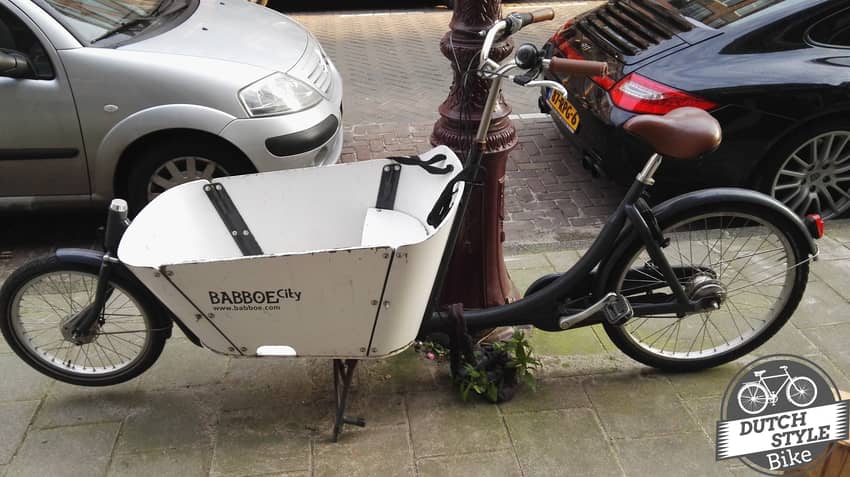
Some Facts About Cycling in Amsterdam
- Amsterdam is a proud owner of the only museum in the world where you can cycle through. It’s Rijksmuseum.
- Bikes are so popular in Amsterdam because in the 1960s and 1970s many people died in car accidents and they started focusing on alternative ways of transportation.
- 60% of the overall daily trips in Amsterdam City Center are by bike!
- There are almost 1 million bicycles in Amsterdam and 854 000 people living here. source: Statista
- Amsterdamers cycle together over 2 000 000 km daily!
- There are 4 times more bikes than cars in Amsterdam.
- 57% of Amsterdammers use their bike on a daily basis.
- There is over 400 km of bike paths in Amsterdam itself.
- Almost 15 000 bicycles are pulled off the Amsterdam canals each year.
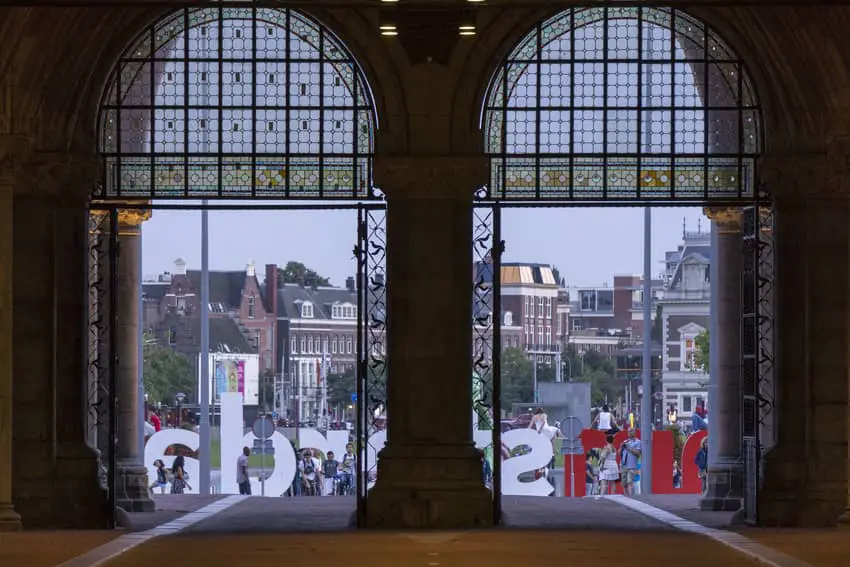
Where to Get a Bike
Tempted to join the hype? Bikes are definitely the best way to move around when you are in Amsterdam, both for tourists and locals. It is an unmissable experience, that is for sure. There are several ways to get your hands on a bike, there are so many that it is hard to miss the chance to get one. In any case, here are my tips for tourists and for newcomers who don’t want to miss out on the experience:
Bikes for tourists
- Ask your hotel: if you are staying at a hotel, there are high chances that they will offer the service of renting a bike. Normally it costs around 15 euros for a whole day, you will probably have to leave a deposit in case something happens with the bike and you will be provided with a bike and its lock. This is a great way of getting the taste of what it is like to cycle in Amsterdam. If the hotel doesn’t have their own bike service, they will for sure provide you with some discount voucher or directions to go to the closest bike shop.
- Black Bikes: this is a good options because they offer all types of bikes all over the city. Black bikes have children bikes, electrical bikes, hand break and pedal break bikes as well as several sizes. It is the largest bike company in Amsterdam, with 14 stores (check them here) and 2000 bikes.
- MacBikes: this is another good options, super close to Amsterdam Central Station, offering a broad selection go bikes: bakfiets, two-person bikes, electric ones, and many more. Check them here.
Pedal break bikes are the cheapest (less than 10 euros for a day), but you have the option of renting any of them for 1 hour, 3 hours, a whole day and so on. Most special bikes are more expensive, 25 euros for one day. But definitely worth the experience.
Bikes for Locals
- Ask your Dutch Friends: my best tip is to ask the experts. Maybe they know someone who has a spare bike, maybe they can lend you one or they even have someone who works for a bike shop. Asking your colleagues, friends or even to your Dutch boss is always a great idea. They are the experts and they will know something. If not, at least you will have a new topic to talk about, and they will give you some good tips about cycling in Amsterdam, locking your bike, fixing it and how many times their bikes have been stolen.
- Marktplaats: have you ever wondered where Dutch people sell or get their stuff? Marktplaats is the place. Here you will be able to find it all, from advertisement about service to a a secondhand IKEA table, clothes and, of course, also bikes. If you are looking for a secondhand bike (or even a new one). I have both bought and sold my bikes with Marktplaats and it has always been a pleasant experience, no troubles, easy and relatively cheap. A secondhand bike will costs you around 100 euros, 20 up or 20 down, depending on how good it is.
- Shops: there are dozens of bikes in Amsterdam and they have both secondhand and new bikes. Some of the most popular ones are WheelGood (where you can rent, bike and repair your bike) and Cheap Bike Shop (for second hand bikes) . You can always ask them for help and they will give you a certificate that the bike isn’t stolen and you will be sure that it is in perfect conditions and it has been checked, even if it has been used before.
- BOL: Another place where you will be able to find it all, from books and stationary to bikes, is BOL. Here you will be able to find all kinds of new bikes, maybe more expensive ones but you are also paying for something more special and aesthetically pleasant.
- Accessories, Locks and Chains: HEMA is the place to go when you don’t really know where you will be able to find something. If you don’t know this shop, it is a very typical Dutch store where you will find everything you need and everything you don’t. It is impossible to get out of there empty-handed and it is definitely a good place for bike accessories.
Tips & Tricks
- Avoid rush hours. The same as on the highway, on Amsterdam cycling paths it can be very busy!
- Amsterdam city center isn’t a good place to learn how to ride a bike.
- Always follow the rules of cycling in the Netherlands